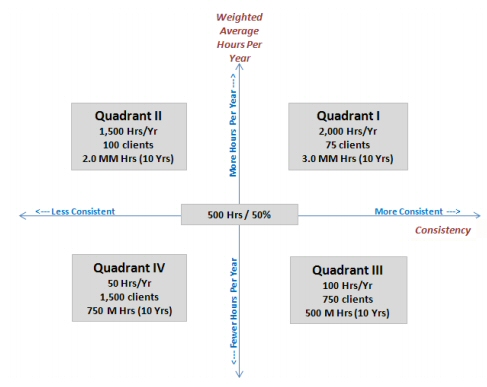LexisNexis Launches Client Analysis for Law Firm Marketing
Client analysis is a four-part suite of client retention tools from LexisNexis Redwood Analytics. Law firm marketing professionals at nearly 100 law firms are using it to mine their clients' historical billings, speed up business development and identify cross-selling opportunities.
The cool part of Client Analysis is that the software will sort clients into target growth, high value or low opportunity categories, as the sample chart below shows. It quickly identifies clients at risk and clients whose billings are decreasing. Early users include Waller Lansden, Haynes & Boone and Baker Botts.
The in-depth analytical reports extract data from finance, and time and billing data which marketing previously had no access to and boils them down into manageable lists, such as number of hours worked for a client, number of new matters and number of partners involved with the client. It's a snap to produce a Top 100 client list and filter it many different ways.
The four primary reporting tools include:
- Profiles: Using the profiles tool, marketers can classify clients based on historical performance and rank them from high performers to those at risk. In addition, LexisNexis atVantage, a competitive intelligence tool, can also be woven into the analysis to determine competitors’ wallet share of a client’s business.
- Self-Service Analysis: Marketers can build customized lists organized and sorted by a variety of basic filters including reports by client, by partner or practice group.
- Cross-Sell Analysis: This reveals which practice areas are billing work to a client and at what wallet share compared to other practice groups. At the same time, firms can look at practice group performance by billable hours per partner, work delivered to other practice groups, , and wallet share percentages for the group at large.
- Trend Analysis: This takes historical data, compares it against client revenue annually, quarterly or over a rolling 12-month period. A chart view of the data depicts cross-sell percentages, types of new matters, numbers of partners working on specific lines of business, and more.

- Quadrant 1— These are superstar clients. These are clients that deliver the largest amount of work with the most consistency.
- Quadrant 2—Clients that deliver large amounts of work, but less consistently. The software can whittle down a 100-client list into the best prospects for lawyers to use business development techniques to move these clients into Quadrant 1.
- Quadrant 3—Clients that deliver less work but on a consistent basis. Lawyers need to visit these clients, learn their business issues and identify how they can be solved with legal services.
- Quadrant 4—Clients that deliver less work on a less consistent basis



